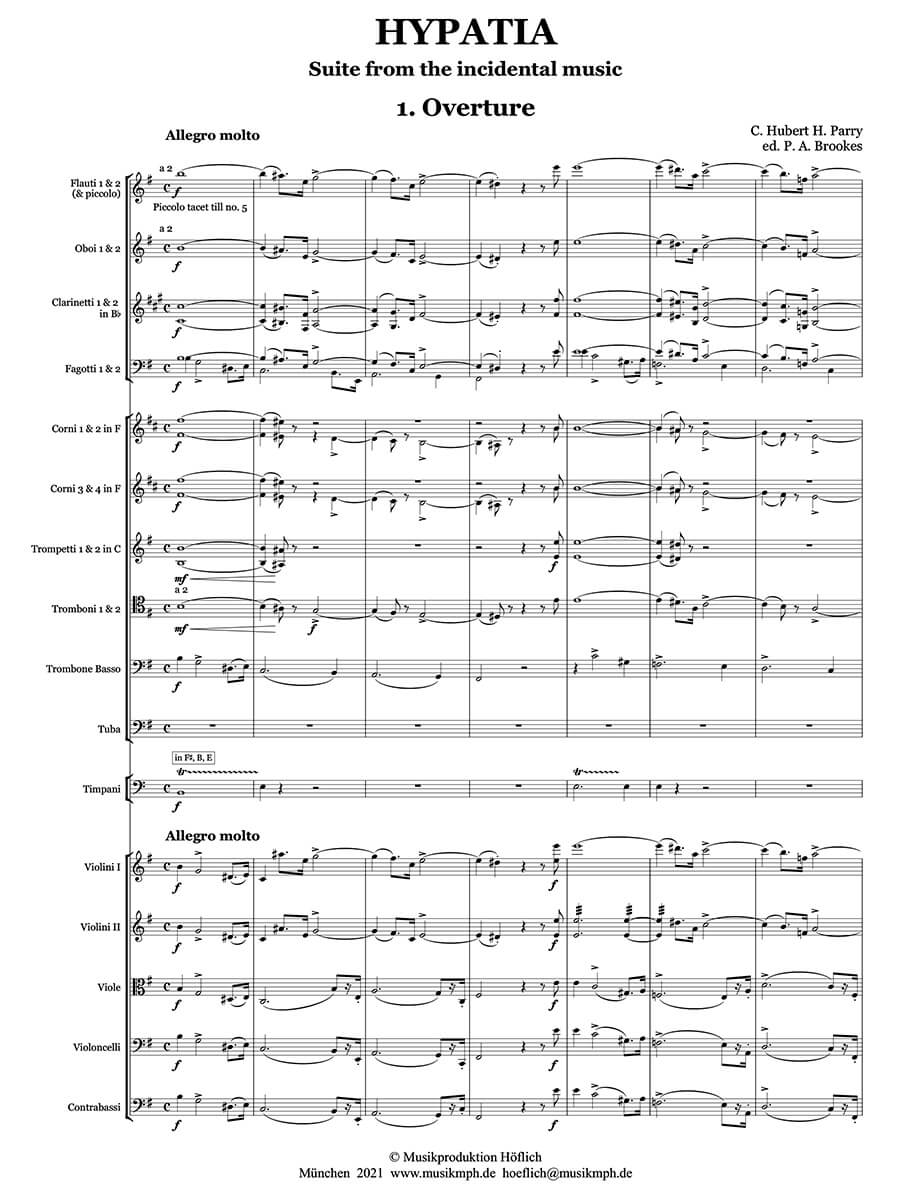Hypatia, suite from the incidental music to the play by Stuart Ogilvie. Edited by Phillip Brookes (new print)
Parry, Charles Hubert
26,00 €
Charles Hubert Hastings Parry – Hypatia, Suite from the incidental music to the play by Stuart Ogilvie (1893)
(b. Bournemouth, 27 February 1848 – d. Rustington, 7 October 1918)
Overture p.2
Hypatia & Philammon p.27
Street Scene p.40
Ruth & Orestes p.54
Orestes’ March p.65
Preface
Parry was an exceptionally busy musician. He was the Oxford Professor of Music, Professor of Musical History at the Royal College of Music (and soon to be its Director) a member of numerous artistic bodies, an author, and a composer. Many of his compositions were commissions for festivals and other events. In 1892 he accepted one such commission to write incidental music for a West End play to be staged at London’s Theatre Royal Haymarket (“The theatre lighted by electricity” announced the programme, giving prominence to the name of the Electrical Engineer) by the flamboyant actor and producer Sir Herbert Beerbohm Tree.
The play was based on Charles Kingsley’s 1853 novel that tells a (fictionalised) story of the life and death of the philosopher, astronomer and mathematician Hypatia of Alexandria, who was a teacher opposed to the rise of Christianity, and who was murdered horrifically by a Christian mob in 415 AD at the prompting of Cyril, the Bishop of Alexandria, after she had spoken against his banishment of Jews from the city. Many of the sentiments of Kingsley’s book betray their Victorian origin – it is heavily anti-Catholic and antisemitic, and it would probably be impossible nowadays to stage the play that Stuart Ogilvie wrote based on Kingsley’s novel, even though Ogilvie toned down some of its prejudices.
Nevertheless the book was a major work in its day, and the opportunity the play afforded was perhaps the nearest Parry ever came to writing a mature dramatic opera, albeit one without any singing. It was not easy working with Beerbohm Tree, who constantly called for changes during rehearsals, and even after the first night. Those changes often meant that Parry had to alter the music. Things reached a climax when Tree demanded a few minutes’ more music for a scene, to which an angry Parry replied, “You don’t want a composer, you want a barrel-organ!” Ogilvie’s play opened on 2 January 1893, with scenery and costumes designed by Lawrence Alma Tadema, and it was a success, running for four months and eventually giving way to another new play, Oscar Wilde’s Lady Windemere’s Fan. Parry’s music was conducted by the noted Wagnerian Carl Armbruster and is of the highest quality – Hazell’s Annual, reviewing the year’s music in London, called it “charming”. ‘The B in a Box’ – the critic in Punch – thought Dr. Parry’s music the best thing about the play, writing “Altogether a notable piece. Prosit!”
The main theme of Orestes’ March is heard in the Overture as well as being alluded to in the Street Scene, giving unity to the suite. The Overture also contains a beautiful brass chorale which, unhappily, does not appear again in the suite. The 2nd and 4th movements (both entr’actes in the play) are charming miniatures. The concluding march is very fine, with a memorable melody. Parry selected these five orchestral numbers for performance at a Royal Philharmonic Society concert, indicating the order in which they should be played. But he did no more – for example, by altering the keys to ensure a more comfortable sequence, or by rationalizing any differences in instrumentation between movements. Such differences were because they were composed with four substantial acts in mind, not a 25-minute concert suite. I have written throughout for horns in F, and trumpets in C. Clarinet parts are for instruments in B flat in the first three movements, and A in the last two.
I have also added a repeat in the last movement, from bar 7 till letter B. This does not appear in the autograph but is suggested in a handwritten note on the score, though it is not in Parry’s hand. Whether it was intended for separate performance in the suite or for theatrical performance, dictated by practical needs discovered in rehearsal, is not known. The repeat works well but can of course be omitted if desired.
Orestes’ March includes cymbals and a side drum that have clearly been added to the autograph, seemingly not entirely in Parry’s hand. A handwritten percussion part exists also that has small parts in pencil in movements 1 and 3 for the same instruments. I have included them in this score, although they too can be omitted if desired.
Phillip Brookes, 2021
For performance material please contact Musikproduktion Höflich (www.musikmph.de), Munich.
| Score No. | |
|---|---|
| Special Edition | |
| Genre | |
| Size | |
| Performance Materials | |
| Printing | |
| Pages |
